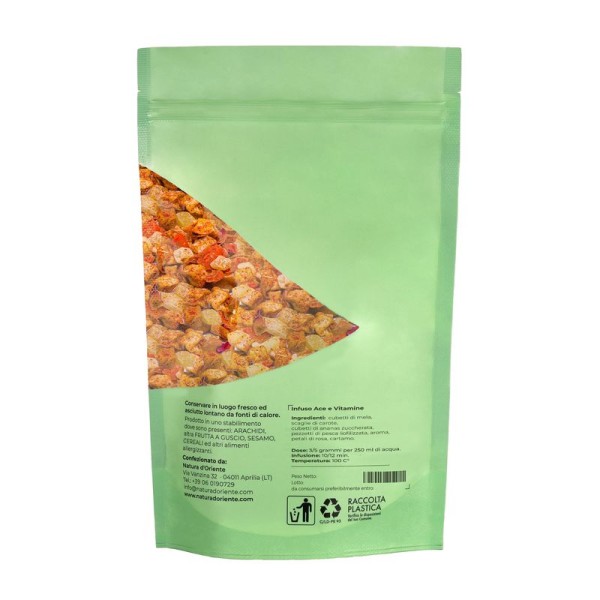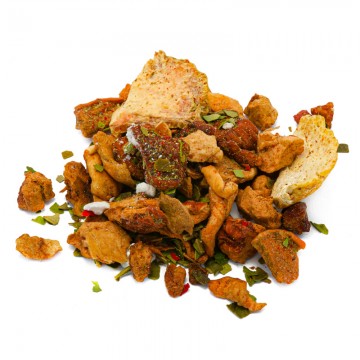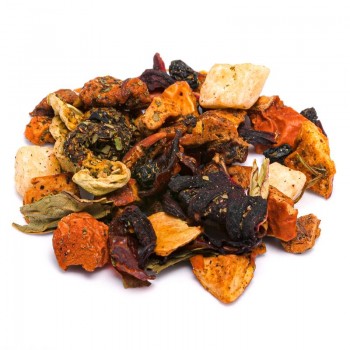ACE stands for the three main vitamins released by the infusion: A, C, E. The name of this drink, therefore, is linked to its beneficial properties, which enhance both three substances and other vitamins. To give its contribution to our body, the mixture for the infusion is made up of various ingredients: apple and pineapple cubes, carrot flakes, freeze-dried peach, rose petals and safflower. There are various properties of this fruity infusion, excellent for giving various "benefits" to the body. In addition, the combination of fruit and flowers does not fail to delight with its intense aroma and lively taste.
ACE infusion: properties and benefits
The nutrition of this infusion is a value that includes vitamins and active ingredients useful for well-being. A tea infused with vitamins, it is designed to bring all the important elements to our body, selected to keep it functioning properly. The unique blend of herbs and fruit aims to improve daily well-being when you need it, through a nutritious and delicious infusion. Vitamins, essential for life and growth, are not made by our bodies – with a few exceptions. For this, a supply through food is necessary. The multivitamin A + C + E "cocktail" complex ensures the right doses. A comfortable cup of ACE infusion gives a good dose of vitamin C, which contributes to the normal function of the immune system, the formation of collagen for the correct function of bones and cartilage. Vitamin C is an antioxidant, capable of counteracting the harmful action of free radicals: through oxidation, they can affect healthy cells and cause aging and pathologies. For this reason, antioxidants such as vitamin C have useful anti-aging and well-being properties. The same action is performed by other elements of the ACE infusion, which contributes to the protection of cells from oxidative stress. Vitamin A, also called retinol, is found especially in the element of carrots in the form of a-carotene, ß-carotene. These are vital substances for cellular metabolism, excellent for the skin and eyesight. Improves skin hydration, regulating cell growth and regenerating tissue. Vitamin E, also called tocopherol is also an important antioxidant. It improves the skin's elasticity, and protects it from the harmful effect of free radicals due to ultraviolet rays. It promotes cell renewal and is considered to contrast the inflammatory factors of the body. Some ingredients, such as peaches, also contain vitamin B, and essential mineral salts. This infusion naturally rich in vitamins also gives energy as well as natural defenses. The supply of nutrients is completely vegetable due to fruit such as apple, peach and pineapple, as well as carrots, rose petals and safflower. Rich in vitamins, these infusion ingredients provide a healthy supply of nutrients to improve physical and mental resistance, most useful during periods of intense activity or seasonal changes. The combination helps avoid vitamin deficiencies sometimes present in diets. In terms of taste, the ACE infusion ensures a break with a fresh and sweet taste, not a citrus note. The brew also tastes fantastic chilled, or as a more nutritious base for smoothies. By adding small pieces of ice, after having left it to cool, you get a refreshing and nutritious drink.
Origins and History of the ACE
The blend features natural elements that evoke the triptych of beneficial vitamins, known only from studies of the twentieth century. The importance of vitamins and the creation of multivitamin supplements and drinks only began in the 1930s. It was around 1934 that Carl Rehnborg, a pioneer in the history of nutrition, decided to create the first multivitamin and multimineral supplement in North America. A product born from the study he carried out in China in the 1920s on widespread malnutrition and the resulting pathologies. The correlation between food and health was direct from his observations. In the countryside, where fresh fruit and vegetables were plentiful, people were much healthier. In the cities, where more sugar, fat and salt were consumed, Rehnborg observed pathologies such as scurvy. The idea that the key to well-being and health were the vitamins of vegetable nutrients was his food proposal. Phytonutrients also include minerals and other beneficial substances, and Rehnborg's research was directed to the development of this diet also with sustainable agricultural practices. Combining these ideas, which have been established for decades now, with the natural contribution of vegetables and fruit, herbal teas and vitamin infusions are born - by now always pmore sophisticated.
Plants and flowers
The components of the infusion are many, and the mixture contains leaves and flowers of different origins. The apple comes from the Malus domestica plant of the Rosaceae family. It is a tree native to Asia, now spread all over the planet. The fruits differ in colors and in the many varieties, and have been used in human nutrition for thousands of years, even in cubes as in the infusion. Pineapple comosus is a plant of the Bromeliaceae family, native to tropical America and widespread today especially in tropical climates. The flowers are purple, pink or red, while the fruits have a shape that resembles a pine cone. The pineapple is actually made up of the plant's flowers and berries, which combine to form a single fruit. The Rose is a perennial plant of the Rosaceae family, famous for its flowers. There are over three hundred species and thousands of cultivars of this plant. It can appear in the form of shrubs, climbers, thorny or not. The flowers change in shape, size and color with petals ranging from white to yellow to red. Most of the species are native to Asia. Daucus carota is a herbaceous plant belonging to the Apiaceae family. Known as one of the most common vegetables, of which the root is consumed. It displays a green stem and fine leaves, and is a biennial plant. It is widespread in Europe, Asia and North Africa. Safflower comes from the branched plant Carthamus tinctorius, of the Asteraceae family. Also called zafferanone (used as a substitute for saffron), it is native to arid environments, with seasonal rains. The orange-yellow flowers are used for infusions and to make cosmetics. Prunus persica is an arboreal plant with a large crown, a species of the Rosaceae family. Peach fruits are usually red with yellow hues and various shades, with more or less intense colors in these shades. The fruits are consumed fresh, dehydrated or freeze-dried.
Nutritional values of ACE infusion and vitamins
The main active ingredients of the infusion are vitamin A (retinoids), vitamin C (L-ascorbate) and vitamin E (tocopherols and tocotrienols). In addition, the ingredients contain natural carbohydrates and sugars, other B vitamins and minerals.
How to use the ingredients in the relaxing herbal tea
The infusion is obtained by placing about 3-5 grams of the ACE mixture with water at 100 °C in a cup (250 ml). Leave to infuse for 10 to 12 minutes before drinking. Add honey or sugar as desired. ACE infusion: side effects and contraindications Even if the infusion brings benefits, it is necessary to respect the doses that are not excessive, and not to use it for too long periods. Excessive intake of these foods can cause diarrhea, nausea, headache. We recommend a medical consultation on the infusion and its ingredients, for pregnant or breastfeeding women.











 No reward points for this product.
No reward points for this product.

![infuso pesca e vaniglia [Natura d'Oriente]](https://www.naturadoriente.com/3538-home_default/infused-peach-vanilla.jpg)
![infuso lime mirtilli rossi [Natura d'Oriente]](https://www.naturadoriente.com/3551-home_default/lime-infused-cranberries.jpg)












